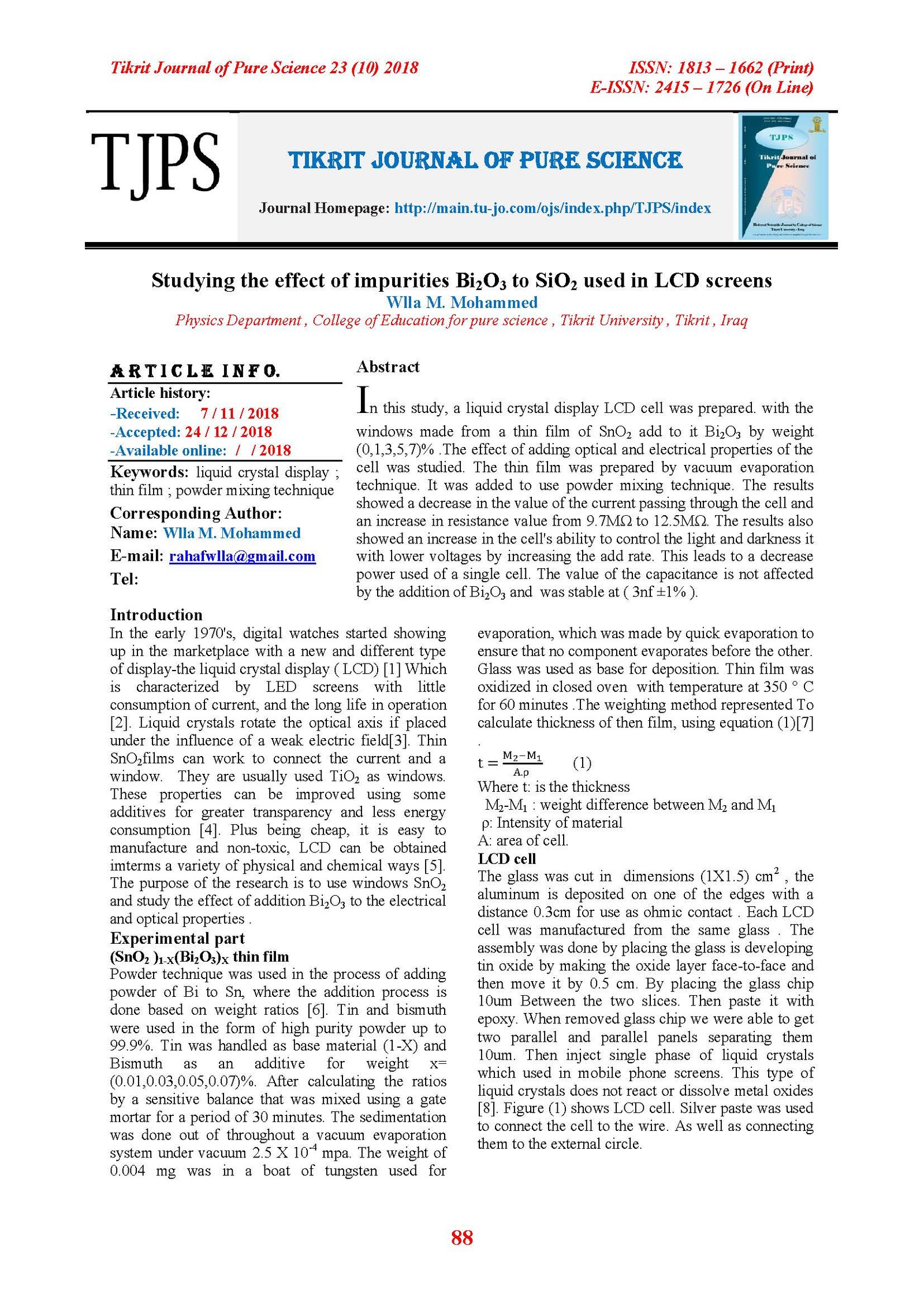Studying the effect of impurities Bi2O3 to SiO2 used in LCD screens
Main Article Content
Abstract
In this study, a liquid crystal display LCD cell was prepared. with the windows made from a thin film of SnO2 add to it Bi2O3 by weight (0,1,3,5,7)% .The effect of adding optical and electrical properties of the cell was studied. The thin film was prepared by vacuum evaporation technique. It was added to use powder mixing technique. The results showed a decrease in the value of the current passing through the cell and an increase in resistance value from 9.7MΩ to 12.5MΩ. The results also showed an increase in the cell's ability to control the light and darkness it with lower voltages by increasing the add rate. This leads to a decrease power used of a single cell. The value of the capacitance is not affected by the addition of Bi2O3 and was stable at ( 3nf ±1% ).
Article Details

This work is licensed under a Creative Commons Attribution 4.0 International License.
Tikrit Journal of Pure Science is licensed under the Creative Commons Attribution 4.0 International License, which allows users to copy, create extracts, abstracts, and new works from the article, alter and revise the article, and make commercial use of the article (including reuse and/or resale of the article by commercial entities), provided the user gives appropriate credit (with a link to the formal publication through the relevant DOI), provides a link to the license, indicates if changes were made, and the licensor is not represented as endorsing the use made of the work. The authors hold the copyright for their published work on the Tikrit J. Pure Sci. website, while Tikrit J. Pure Sci. is responsible for appreciate citation of their work, which is released under CC-BY-4.0, enabling the unrestricted use, distribution, and reproduction of an article in any medium, provided that the original work is properly cited.
References
[1] Slater, M. (1989). Microprocessor-Based Design. Prentice-Hall: 348-361.
[2] Bahadur, B. (1990). Liquid Crystals, Applications and Uses. World Scientific: 310 pp.
[3] Loughlin, M. and graw, I. (2011). Computer Peripherals. Mcgraw-Hill: 179-204.
[4] Fang, F.; Xiaoqin, W. and Zhang, Y. (2015). Electrical and optical properties of nitrogen doped SnO2 thin films deposited on flexible substrates by magnetron sputtering. Materials Research Bulletin, 68:240-244 .
[5] Thirumoorthi, M.; Thomas, J. and Prakash, J. (2016). Effect of F doping on physical properties of (211) oriented SnO2 thin films prepared by jet nebulizer spray pyrolysis technique. Superlattices and Microstructures, 89:378-389.
[6] Kawasaki, H. and Ohshima, T. (2017). Preparation of Sn doped SiO2 films using SiO2 and SnO2 mixture powder target by magnetron sputtering deposition. Transactions of the Materials Research Society of Japan, 42(3):1382-3469.
[7] Vaizoğullar, A.I. and Balc, A. (2014). Synthesis and Characterization of ZnO/SiO2 Core-Shell Microparticles and Photolytic Studies in Methylene Blue. International Journal of Research in Chemistry and Environment, 4(2):161-165.
[8] Wang, X. and Zheng, Z. (2017). Light-Driven Liquid Crystal Circular Dammann Grating Fabricated by a Micro-Patterned Liquid Crystal Polymer Phase Mask. Polymers, 9(8):380-385.
[9] Thomas, L.F. (2005). Electronic Devices. 7th edn., Pearson Prrentice Hall:950pp.
[10] Lee, W.K. and Choi, H.J. (2009). Low-power operation of vertically aligned liquid-crystal system via anatase- TiO2 nanoparticle dispersion. Optics Letters, 34(23):3653-3655.
[11] Raha, A. and Benhaoua, A. (2015). Structural, optical and electrical properties studies of ultrasonically deposited tin oxide (SnO2) thin films with different substrate temperatures. Superlattices and Microstructures, 86: 403-41.
[12] Bouras, K. and Schmerber, G. (2016). Structural, optical and electrical properties of Nd-doped SnO2 thin films fabricated by reactive magnetron sputtering for solar cell devices. Solar Energy Materials and Solar Cells, 145(2):134-141.
